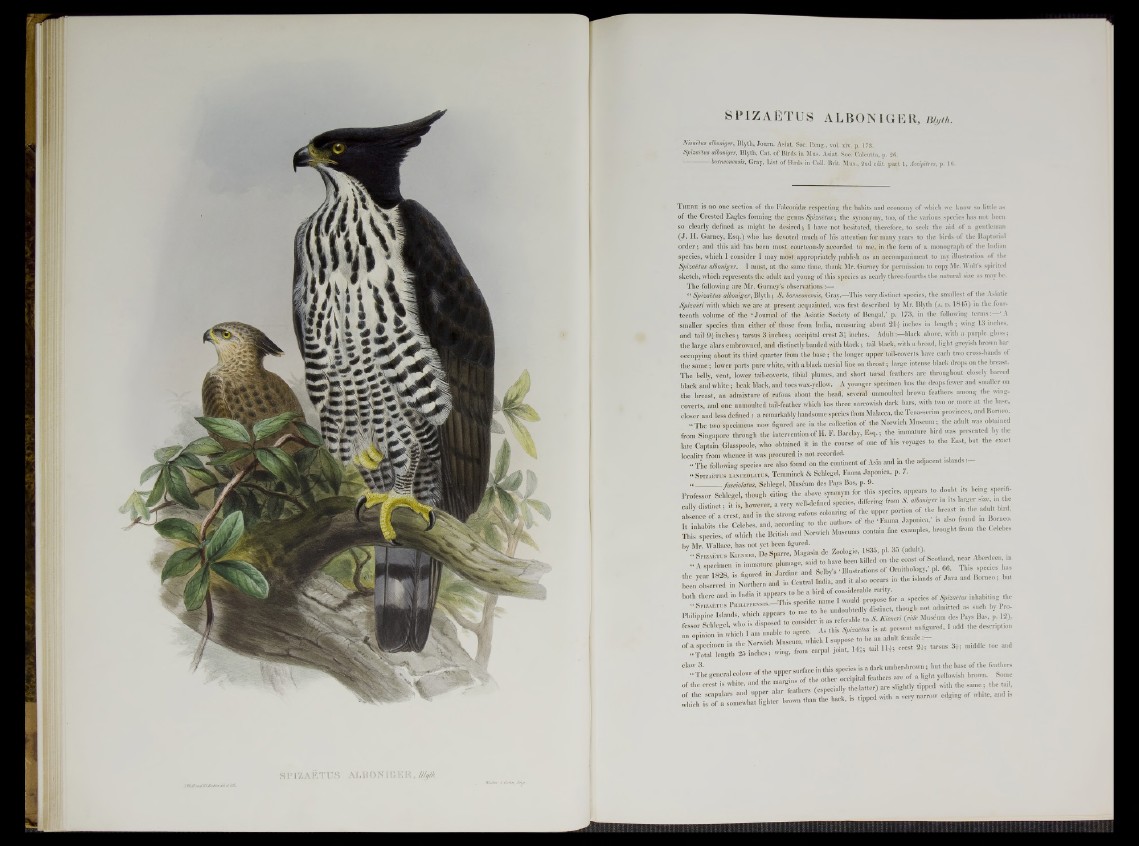
SPIZAl iTUS ALBONIGER, myth.
Nisaetiis alboniger, Blyth, Journ. Asiat. Soc. Beng., vol. xiv. p. 173.
Spizaetus alloniger, Blyth, Cat. of Birds in Mus. Asiat. Soc?Calcutta, p. 26.
— lomeonensis, Gray, List of Birds in Coll. Brit. Mus., 2nd edit, part 1, Accipitres, p. 16.
T h e r e is no one section of the Falconidse respecting the habits and economy of which we know so little as
of the Crested Eagles forming the genus Spizaetus; the synonymy, too, of the various species has not been
so clearly defined as might be desired; I have not hesitated, therefore, to seek the aid of a gentleman
(J. H. Gurney, Esq.) who has devoted much of his attention for many years to the birds of the Raptorial
order; and this aid has been most courteously accorded to me, in the form of a monograph of the Indian
species, which I consider I may most appropriately publish as an accompaniment to my illustration of the
Spizaetus alboniger. I must, at the same time, thank Mr. Gurney for permission to copy Mr. Wolt’s spirited
sketch, which represents the adult and young of this species as nearly three-fourths the natural size as may be.
The following are Mr. Gurney’s observations:—
“ Spizaetus alboniger, Blyth; S. borneonensis, Gray.—This very distinct species, the smallest of the Asiatic
Spizaeti with which we are at present acquainted, was first described by Mr. Blyth ( a . d . 1845) in the fourteenth
volume of the ‘Journal of the Asiatic Society of Bengal,’ p. 173, in the following terms: ‘A
smaller species than either of those from India, measuring about 214- inches in length; wing 13 inches,
and tail 94-inches; tarsus 3 inches; occipital crest 34 inches. Adult:—black above, witb a purple gloss;
the large alars embrowned, and distinctly banded with black; tail black, witb a broad, light greyish brown bar
occupying about its third quarter from the base; the longer upper tail-coverts have each two cross-bands of
the same; lower parts pure white, with a black mesial line on throat; large intense black drops on the breast.
The belly, vent, lower tail-coverts, tibial plumes, and short tarsal feathers are throughout closely barred
black and white; beak black, and toes wax-yellow. A younger specimen has the drops fewer and smaller on
the breast, an admixture of rufous about the head, several unmoulted brown feathers among the wmg-
coverts, and one unmoulted tail-feather which has three narrowish dark bars, with two or more at the base,
closer and less defined : a remarkably handsome species from Malacca, the Tenassenm provinces, and Borneo.
“ The two specimens now figured are in the collection of the Norwich Museum; the adult was obtained
from Singapore through the intervention of H. F. Barclay, Esq.; the immature bird was presented by the
late Captain Glasspoole, who obtained it in the course of one of his voyages to the East, but the exact
locality from whence it was procured is not recorded.
“ The following species are also found on the continent of Asia and in the adjacent islands:
“ S p iz a e t u s l a n c e o l a t u s , Temminck & Schlegel, Fauna Japonica, p. 7.
*«------------ fasciolatus, Schlegel, Museum des Pays Bas, p. 9. , . • > • -c
Professor Schlegel. though citing the above synonym for this species, appears to doubt its bemg spec,finally
distinct I it is, however, a very well-defined species differing from | | | |
absence of a crest, and in the strong rufous colouring of the upper portion of the breast in the adult bml.
j- . , f i rviehps and according to the authors of the ‘Fauna Japonica, is also found in Borneo.
Tlds i e l s of wtch the British aud^orwich Museums contain line examples, brought from the Celebes
by M , de Zoologie, 1835, pl. 35 (adult).
S p iz a e t u s Kiexs , p' »S* haye been kiUed on the coa8t 0f Scotland, near Aberdeen, in
“ A specimen I^n .mmature pht g , _ 1 pL g xhis species has
m m m m m and I Centml India, and I also occurs in the islands of Java and Borneo; but
both there and in In d ia tR jp e^ “ ^ for a species of Spizae'us inhabiting the
■‘ S p iz a e t u s ' Pme I be undolIbtedly distinct, though not admitted as such by Pro-
Philippme Islands, which appe referable to S. Kimeri (ride Museum des Pays Bas, p. 12),
f e s s o r Schlegel, wlio .s^d,sp<«e o ^ ¡s at present unfigured, I add the description
an opinion in which 1 am unauie in ' JHUHi femalp*__
m m in the Norwich Museum, which M I middle toe and
••Total length 25 inches; wing, from carpal joint, 14., tail 11T,
claw 3 ’ . , this snecies is a dark umber-brown; but the base of the feathers
•• The general colour of the upp ^ ^ ^ rf a ,igbt ycu„wish brown. Some
of the crest is white and the marg^ the latter) are slightly tipped with the same; the tail,
of the scapulars and upper a . / , . . , VAPV n arrow ede-inar of white, and is